Singularity Chess
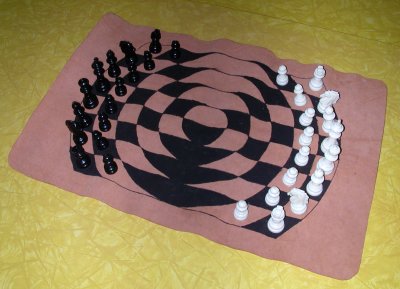
I originally ran across this chess variation back when I was a graduate student in mathematics at the University of Wisconsin-Madison. We're talking late 70s or early 80s. I found this game described on a calendar in the math department library. Thinking back, I'm not sure just what the name of the game was. I call it "singularity chess," or "whirlpool chess," for reasons that will become evident.
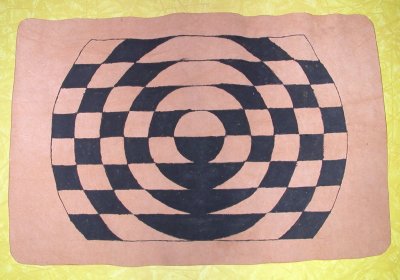
I made a board for myself on a piece of leather. Any small set of chessmen will do. You'll notice that the "squares" on the board are not really square— they range from more or less square to semicircular. Even though the "squares" differ in shape, each "square" has four sides and four corners.
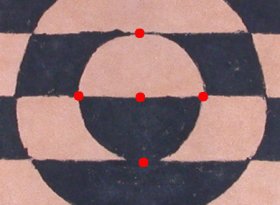
Even the two semicircular "squares" at the center of the board have four sides and four corners. (Corners indicated above in red.) These two "squares" share two sides and three corners in common. The corner between them which lies at the very center of the board is the singularity from which this chess variation takes its name.
Since the board layout is a "curved space," straight moves and diagonal moves have to be defined locally instead of globally. A straight move can be defined as a move which enters a "square" through one side, and may continue on to exit the "square" through the opposite (nonadjacent) side. A diagonal move can be defined as a move which enters a "square" through one corner, and may continue on to exit the "square" through the opposite (nonadjacent) corner.
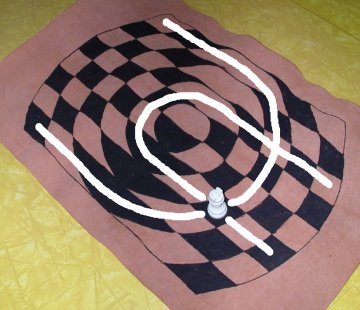
This leads to some long-distance moves which are anything but straight as we think of straight. Notice how the rook's move can take it looping around the center of the board, and right back like a boomerang to the same side of the board it started from.
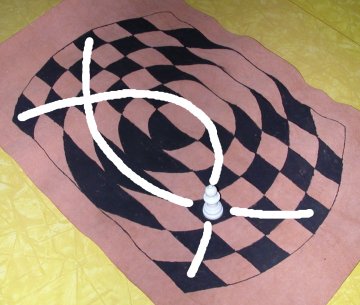
The bishop's move also loops around the singularity at the center of the board. Thus the same bishop can sometimes threaten a square from two different directions at once.
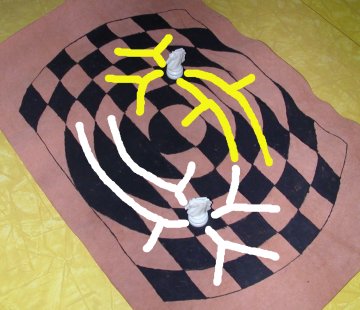
The knight's move likewise is distorted in an almost psychedelic fashion. (First knight's moves in white, second knight's moves in yellow.)
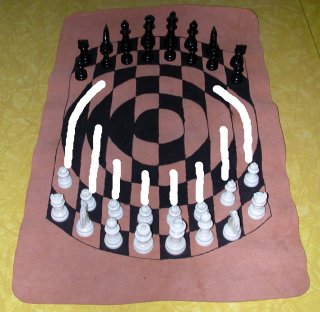
I don't recall exactly how the pawns moved. It seems to me that a rook's pawn could end up "curving" if it went two spaces on its first move— probably not wise for it to move that far while there are still enemy pieces in that vicinity.
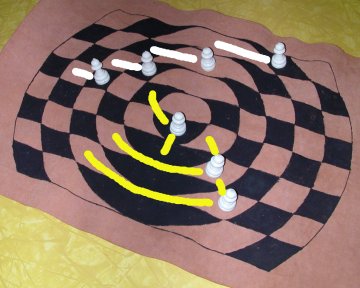
As a pawn reaches the semicircular "squares" at the center of the board, it makes sense to me to have it continue to move toward the far side of the board, even though technically this amounts to having the pawn move "sideways" instead of "forward." (Move "forward" indicated in white.) It looks "forward" to us, and it's the only way the pawn will ever make it to the far end where it can be promoted.
It would also make sense to have the pawn's "forward" diagonals for capturing be through the two corners on either side of its next "forward" move. (Indicated in yellow.) Though this would mean that a rook's pawn still on its original square could capture the opposing rook's pawn on its original square— not sure whether that should be permitted or disallowed.
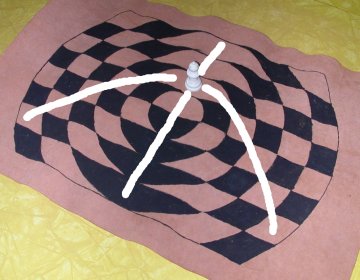
One odd feature of the singularity, or "corner" at the center of the board, is that a piece which moves "diagonally" through the singularity will come out on squares of the opposite color. Thus the bishop above starts on a white square, but if it moves through the singularity, it will end up on a black square.
Odd game. Back in those days you didn't find too much about strange chess variations like this. Though in today's world a hundred mutant flowers have bloomed: I wouldn't be surprised if there are websites out there nowadays about singularity chess.
Labels: games








8 Comments:
Cool & strange-looking.
How about singularity Chinese Checkers? That would knock their socks off over at peirce-l.
Hmmmm... Singularity Chinese Checkers?? And I know just the person who could draw a diagram of the board... I've been enjoying your diagrams of Peirce's tenfold categorial division of the sign on peirce-l recently.
BTW, I've looked around, and there's nothing else out there about "singularity chess" or "whirlpool chess"— not under those names, anyway. Also made a cursory search through the vast number of "circular" chess variations described at ChessVariants.org, and found some interesting games, but nothing answering to what I call "singularity chess." Maybe I just haven't looked in the right places yet.
I liked this so much, I included a link in this post.
This is so cool! Singularity Chees is a perfect name. You can use the movements to describe how matter and space itself travels trought time, and you would not have to go too far in a descripcion of basic particles too see the very same pattern in those pictures above.
I´m making myself one like, immediately.
This is an amazing chess variant.
I noticed a few things about this; this chess variant is difficult to follow unless one were to vigorously mark down the vertices for each square. This would also mean the singularity acts as a color changer: it means bishops can change colors, knights can land on a square of their initial square color, etc, etc, most of which you've already outlined.
Because I loved this so much, I wanted to add a few things just to make this as "official" as we can. I'm going to go and say that pawns are not affected by the singularity in terms of movement. This means pawns must go straight forward when looking at the board. Therefore, the rook-side pawns can only move one square on their first turn.
Sorry. I'm just really excited about this.
How can the squares be noted? For example a1, a2, c3, c4, etc...
I noticed that it makes a difference either we define the knights move as a series of one straight and one diagonal move or two straight and a third straight move perpendicular to the first two (the L shape). The problem is that if we define it the first way it allows the knight to arrive at the same color as it started from by the diagonal move being the one across the middle singularity. That's why i like the second way better. I hope i explained it understandably
Good readingg your post
Post a Comment
<< Home